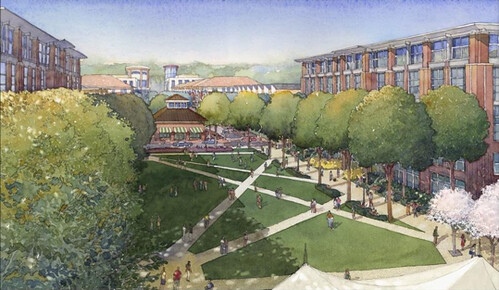 |
| LifeSci Village, a proposed bioscience research campus that's part of a new plan for White Oak. |
While White Oak has several historically affluent neighborhoods, today it has no majority racial or ethnic group, and renters make up over a third of the population. There are abandoned office buildings and a reputation for crime, whether real or perceived. Residents have to go long distances to Bethesda, the I-270 corridor or DC for work, shopping or other amenities.
Planners found that residents are frustrated with the status quo. "There is great interest in seeing 'things happen'," they write in a draft of the White Oak Science Gateway Master Plan, a proposal to transform White Oak's strip malls and office parks into a "vibrant, mixed-use, transit-served" research and technology center.
Plan calls for three urban nodes, new parkland
Planners envision creating three new "activity centers" clustered around the Food and Drug Administration, whose 9,000 employees began moving here in 2009, and Washington Adventist Hospital, which wants to move here from Takoma Park.
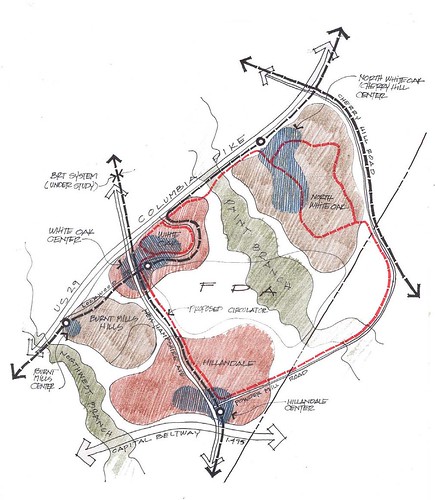 |
| Concept drawing of the White Oak Science Gateway from the Montgomery County Planning Department. |
"We have to create a compelling reason for people to come here," says Jonathan Genn, executive vice president at Percontee. Bioscience workers "tend not to [have] your normal 9-to-5 week," he adds. "They're working nights and weekends. They want that vitality."
Designed by New Urbanist architecture firm Torti Gallas and Partners, the $3.2 billion project would contain a research campus with several "world-renowned" academic institutions, along with offices and labs, a hotel and conference center. There would be a commercial district with shops, restaurants and entertainment venues, and up to 5,300 new homes, including apartments, townhomes and some single-family homes.
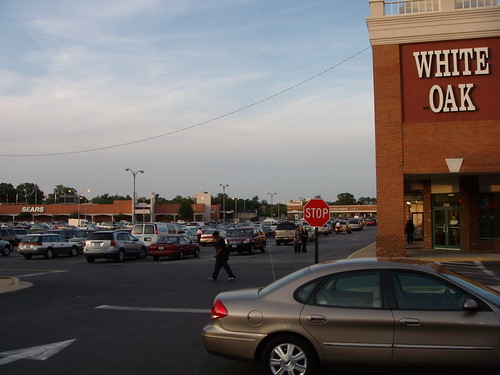 |
| The White Oak Shopping Center in 2009. Photo by the author. |
The third would be in Hillandale, where both Georgetown University and Montgomery College have expressed interest in buying the former National Labor College campus at New Hampshire Avenue and the Beltway.
Meanwhile, residents would get a larger open space network, including neighborhood parks, a recreational park and a proposed, 130-acre expansion of Paint Branch Park into the FDA property, the vast majority of which is unused.
Planners seek new approach to congestion
The Science Gateway plan is a 180-degree turn from previous plans for White Oak and East County, which sought to keep the status quo. Planners say that old solutions won't fix White Oak's real issues, and that improving transit and bringing amenities closer to where people live is the best way to handle traffic.
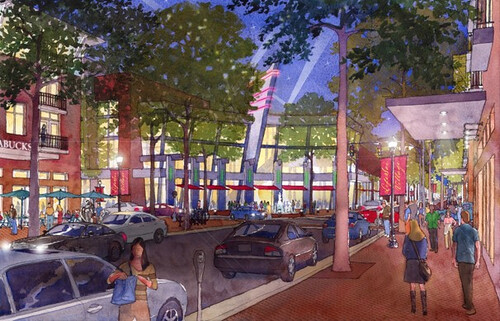 |
| Image of the commercial district at LifeSci Village from Percontee. |
"Creating a really vibrant, mixed-use community . . . is a mitigating factor," says Genn. "People can walk to work, bike to work, people can do other activities after work. All of those things mitigate traffic impact at rush hour."
In total, the Science Gateway plan allows up to 8,500 new homes and 13 million square feet of new commercial space containing up to 43,000 new jobs. That's more than double the amount of homes and commercial space here today, and nearly triple the amount of jobs.
Planners hope that new transit and improved local street connections will help reduce the Science Gateway's traffic impacts. Montgomery County's proposed Bus Rapid Transit network would connect the three centers to each other and to the rest of the region with lines along Route 29 and New Hampshire Avenue, and Randolph Road.
 |
| BRT lines currently under study (in blue) and an extension to LifeSci Village (in green). Image from the Montgomery County Planning Department. |
The plan also calls for connecting dead-end streets where possible and building a new street grid at the White Oak Shopping Center and LifeSci Village. Planners recommend rebuilding a bridge that carries Old Columbia Pike over the Paint Branch, which was closed to cars 30 years ago, and creating a network of "green streets" with bike lanes.
By giving residents, workers and visitors alternatives to driving, the plan's goal is that 30% of all trips will be made without a car by 2040. That may seem unrealistic, but 25% of White Oak residents already commute to work by foot, bike or transit today. The Metrobus K and Z lines, which serve White Oak, are some of the most-used routes in suburban Maryland.
Strict staging requirements would ensure that new development wasn't occurring without the public infrastructure needed to support it. Under the plan, most of the development wouldn't occur until after the Bus Rapid Transit lines on Route 29 and New Hampshire were funded and built. The Planning Department would have to submit reports every 2 years showing that infrastructure has caught up to development.
Science Gateway could improve jobs-housing imbalance
While the Science Gateway could help fix the region's jobs-housing imbalance by putting more jobs on the east side, closer to where the most affordable housing is, reducing the need to commute to the I-270 corridor or Northern Virginia for work. There are no fewer than 5 plans each calling for a similar amount of development as in the White Oak plan along I-270, like the the Great Seneca Science Corridor in Gaithersburg, which both residents and smart growth advocates criticized for putting too much development in an isolated area.
Many of them suggested that White Oak was a better location for it, and East County residents agree. In 2009, the East County Citizens Advisory Board demanded more jobs and investment in the area, while visitors to a 2010 open house advocated for more density and transit.
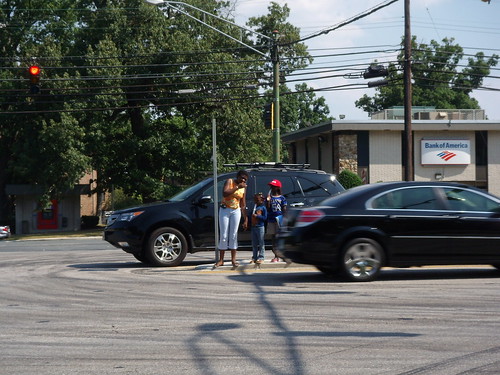 |
| Improving pedestrian, bike and transit connections could help traffic in White Oak. Photo by the author. |
Nonetheless, most of the Science Gateway isn't allowed under the county's Adequate Public Facilities Ordinance, which discourages new development in congested areas based on the assumption that everyone will drive everywhere no matter what. But "even if Montgomery County limited development," planners note, "regional and local traffic will continue to congest the highway network."
To make White Oak eligible for new development, planners simply recommend not including regional highways like Route 29 and the Beltway in traffic counts, which would lower the area's traffic counts, making it eligible for new housing and job growth.
Not everyone's convinced, however. "This just means we're going to suffer from more traffic," said Alison Praisner Klumpp, Calverton resident and current member of the East County Citizens Advisory Board, said at a presentation on the plan earlier this month. Carole Ann Barth, president of the Montgomery County Civic Federation and a resident of Four Corners, called the plan "shallow, simplistic and ultimately impractical" while claiming it would force people to live in apartments against their will.
Plan needs transit, some industry to succeed
As someone who currently lives and bikes in White Oak, I'm excited by the Science Gateway plan. Having more jobs, shopping and housing choices in East County will encourage hopefully make this area a destination of choice once again. However, this plan can't happen without good transit, especially a direct connection to LifeSci Village.
While the staging requirements require BRT to be funded and built before major development occurs, the county's current plans call for buses without dedicated lanes on much of New Hampshire Avenue and Route 29. Without fast, reliable transit, people will continue to drive, placing an undue burden on area roads.
 |
| Should we keep some light industrial activity in White Oak? Photo by the author. |
Studies show that a majority of Americans across racial and generational lines want to be close to transit, jobs, shopping, dining and entertainment, and communities across Montgomery County and the region are responding. If White Oak wants to reclaim its former prosperity, it can and should follow suit.
The Montgomery County Planning Board will hold a public hearing on the White Oak Science Gateway Master Plan this Thursday at 6:30pm at the Planning Department, located at 8787 Georgia Avenue in Silver Spring. To sign up to testify or send written comments, visit their website.

7 comments:
I'm all for improving White Oak, which could use some attention. But I'm disturbed by the plan to "redevelop" the existing apartments in the area, which seems to be just a euphemism for "get rid of those low class renters and replace them with younger, more affluent people". Subsidized "affordable housing" would only cover a small percentage of the people who currently live in the area. Most people wouldn't qualify. They'd just be displaced and have to relocate to some other area (probably somewhere outside Montgomery county). Considering the number of empty or underused buildings in White Oak, it makes me wonder why existing apartments are going to be razed - unless the plan is really to get rid of the people who live there.
@Karen
It's not a done deal that the apartments would be redeveloped - the plan just makes it possible, and it's up to the individual property owners to do something about it.
I share your concerns about preserving affordable housing, though many (but not all) of those buildings were built in the 1960's-70's and will need a lot of work to stay in good shape, which will cost money. For some property owners, the cost of renovations may be incentive enough to scrape the buildings and start over. We'll have to see what actually happens.
Personally, I'm much more excited about redeveloping the White Oak Shopping Center, though I do enjoy having the Beer & Wine store and one of the only 3 grocery stores in the county that sell beer & wine in the same place.
I am down for razing the apartment. Check out crimereports.com and see the amount of crime from those apartments. Rape, assault, sexual assault are all prominent events.
I could care less about "housing equality." The safety of my kids and neighborhood trumps that.
@beerman
I'm sorry you feel that people who make less money than you don't deserve to live in our community and somehow pose a threat to your family because, of course, all low-income people are criminals.
There may be legitimate issues with crime in East County, but kicking all of the low-income people out (which, let me make clear is not part of the Science Gateway Plan) isn't suddenly going to fix that.
Let us not all forget that in the D.C. area, low-income could mean a recent college grad or a public servant. Like Dan said, not all low-income individuals are criminals.
Guess I will take my family and income else where. Virginia is nice, and they don't infringe on the constitution like MD does!
@beerman
Tell E.W. Jackson I said hi!
Post a Comment